INDUSTRIAL SAFETY – TEAM EFFORT
Safety and health hazards exist all around us, but it is our daily approach to these that determines the outcome.
When you go to work each day, an accident is the last thing you expect to happen. Unfortunately, workplace accidents are happening more frequently. In fact, the Bureau of Labor Statistics’ Census of Fatal Occupational Injuries most recent report states a seven percent increase in workplace fatalities.
Safety is a responsibility, one that takes cooperation from everyone involved with the organization. It requires a team effort from three key sources – the employer, the employee, and your first aid product supplier.
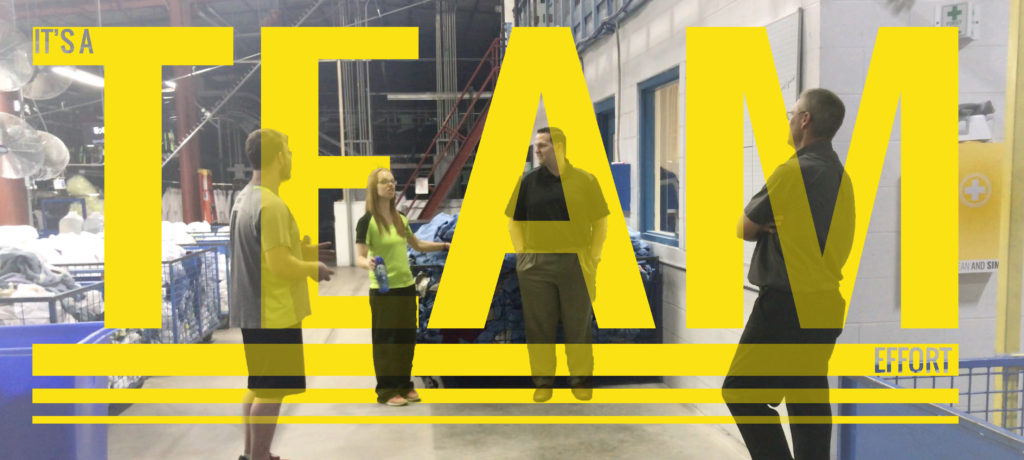
EMPLOYER RESPONSIBILITY
Valuing Safety
Under OSHA (Occupational Safety and Health Administration), the OSH Act states employers are ultimately responsible for developing and promoting a safety culture that is an integral part of the organization. But many organizations don’t know what that means or even where they should start.
Putting safety first above all things is the most crucial first step an employer can take. A work environment that values safety over productivity will prove that the company is sincerely committed to its employees.
Employers can establish their safety commitment by understanding the importance of leadership participation. Senior leaders steer the organization by example. If safety is at the forefront of their minds and actions, employees will follow suit.
“We focus on safety and make sure it’s part of our everyday work environment,” Nicole O’Brien, CITY’s human resources manager, said. “We’re always working on safety and meet once a month as a committee to talk about safety issues, near-misses, injuries that have happened, and injury prevention.”
Safety Management and Practices
To see safety success, an organization must establish clear worker safety and health protection policies and then communicate them to all employees. Then, leadership must continuously manage their safety policies, procedures, and processes.
Safety is non-negotiable. Employees must receive continuous training, monitoring, and supervision to ensure no corners are cut when making business decisions.
Preventing Hazards
Every workplace has safety hazards, but it’s what you do with each hazard that matters. Prevention is a company’s best defense against injuries.
The first prevention step is to identify hazards in the workplace. Most workplace hazards can be organized into four main categories.
- safety hazards – the most common workplace hazards, including slip, trip and fall; moving machinery; or electrical hazards
- biological hazards – associated with working with animals, people, or infectious plant materials. These include blood and bodily fluids, fungi/mold, bacteria and viruses, plants, insect bites and animal waste.
- physical hazards– includes factors within the environment that cause damage to a person’s body without physical touch. For example, high exposure to sunlight, UV rays, or temperature extremes.
- chemical hazards – when an employee is exposed to any chemical preparation in the workplace including solids, liquids, and gases (cleaning products, solvents, gasoline, pesticides, etc.)
The best way to protect employees from workplace hazards is to identify each hazard that is relevant to their work environment and take reasonable steps to prevent their potential to harm.
Corrective and Preventative Action
In the event of a workplace injury, actions taken identify, eliminate, and reduce the occurrence of adverse events are known as a CAPA (Corrective and Preventative Action) process.
- corrective actions– designed to correct noncompliance and eliminate the recurrence of injury caused by a workplace hazard. These actions are recorded and include the steps that are taken to prevent future occurrences.
- preventative actions – designed to determine and eliminate workplace hazards that have not yet caused a problem, but risk for an adverse event is present. The big question here is, “What if?”
The CAPA process also includes meetings, inspections, accident investigations, and reporting.
Staying Up-to-Date (with policy & regulation changes)
Safety policy and regulations are constantly improving. Employers must strive to be aware of changing guidelines so that employees are safe, healthy, and compliant. Employers can do the following to stay up-to-date:
- Follow news and events in your industry.One of the easiest ways to do this is to subscribe to newsletters, magazines, or podcasts that discuss important issues in your particular industry.
- Network with others in your industry. It’s difficult to stay on top of every piece of information that comes across your desk, but networking with others can help eliminate excess noise and help you focus on what you need to know. You can learn what others in your industry are doing in order to stay safe and compliant.
- Identify the people and organizations where you can get advice and support. If you need help finding, understanding, or complying with a regulation, it’s very valuable to reach out to an organization that can help ensure you are doing everything correctly.
EMPLOYEE RESPONSIBILITY
While an employer is responsible for managing safety and providing a healthy work environment, the employee also plays an important role in a company’s accountability.
First and foremost, an employee must comply with the standards, rules, and regulations issued by the organization. This includes wearing appropriate personal protection equipment (PPE) such as uniforms, gloves, safety glasses, etc.
Speaking up to voice concerns or to give suggestions is one of the most significant safety contributions an employee can make. Lastly, an employee can support safety by inspiring others to value safe work practices.
“We have a promotion that is ongoing called the ‘See Something, Say Something’ campaign,” O’Brien said. “We encourage employees to report it if they something that feels unsafe, whether that’s directly to their supervisor or anonymously by filling out a campaign sheet in the break room.”
IMPROVING WITH CITY
As a total solutions provider, we offer clients the ability to focus on their business instead of having to delve into the uniform business. We take care of it all, from sizing and fitting, to responsive delivery and communication. Leave it to us to ensure your employees are safe and compliant.
The Reason for Uniforms
Uniforms are perfect for a variety of safety reasons. The top safety reasons for requiring uniforms include:
- Consistency. Employees will never have to guess what they should or shouldn’t wear because requiring uniforms ensures all employees are dressed appropriately and safely for their particular work environment.
- Added protection. Uniforms have specific functional benefits that prevent injuries. Examples include uniforms that are fitted to avoid being caught in moving machinery, are flame resistant (FR), or have high-visibility capabilities.
- Improved security. Having uniforms that feature particular styles or colors helps quickly identify employees and assists with directing the correct employees to the proper work areas. Furthermore, employees can better communicate with clients when interacting with the public or entering homes as uniforms help create a sense of familiarity and trust.
“Any ancillary benefit you can provide people is really a huge attractant and retention tool,” Colin Wetlaufer, CITY’s president, said.
UNIFORMS MINIMIZE RISK EXPOSURE
Employee uniforms are perfect for promoting team spirit and spreading your brand, but they also serve a much greater purpose. Uniforms provide safety protection for many industries. Providing employees with proper uniforms for a variety of work environments is a key component to keeping employees safe and OSHA compliant.
Safety Hazards
These hazards are the most common and are present in nearly every work environment.
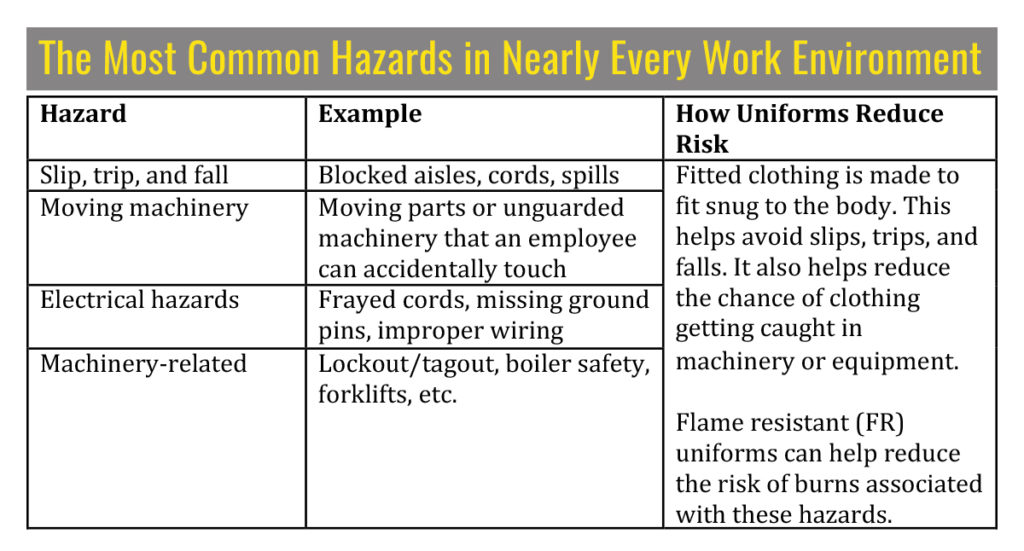
Physical Hazards
These hazards include factors that are within the environment. They can cause damage to a person’s body without physically touching anything.
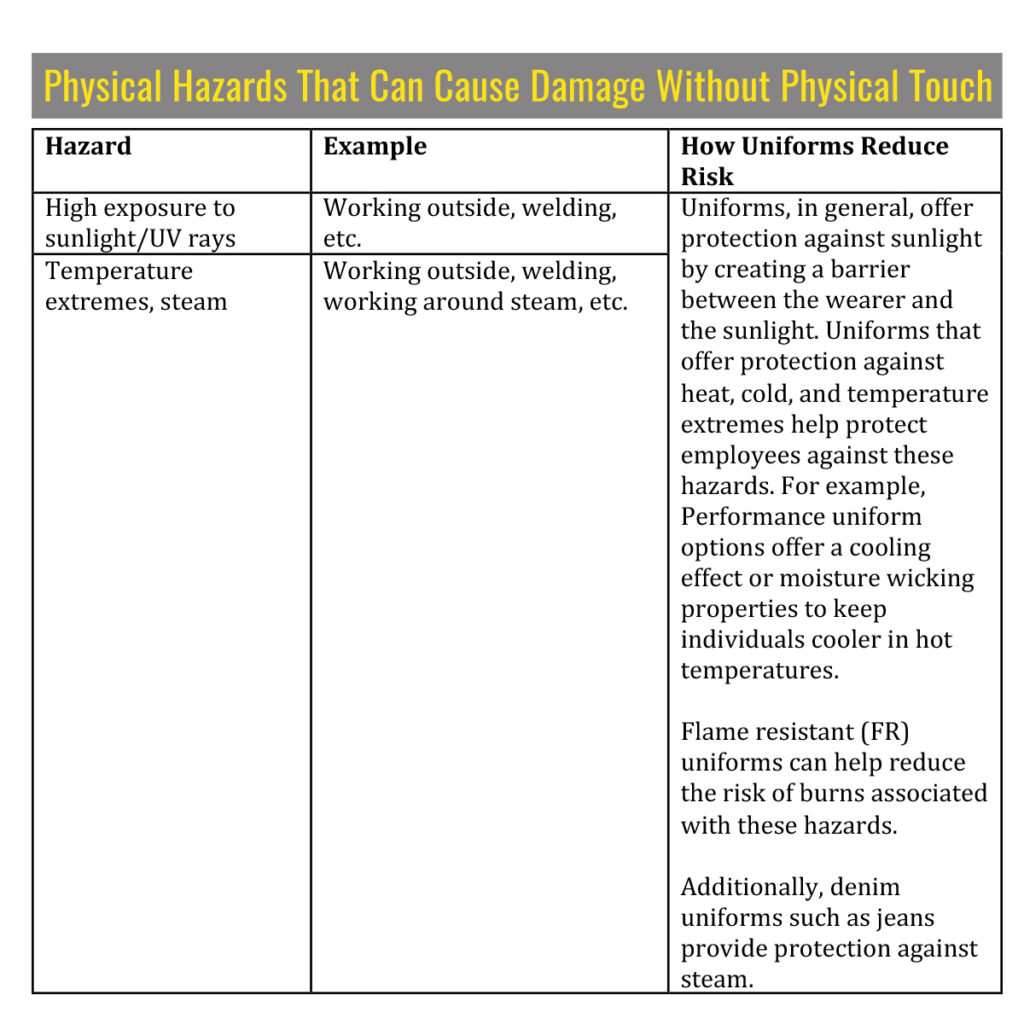
Chemical Hazards
These hazards are present when an employee is exposed to any chemical preparation in the workplace including solids, liquids, and gases. Common issues with these hazards include illness, skin irritation, and breathing problems.
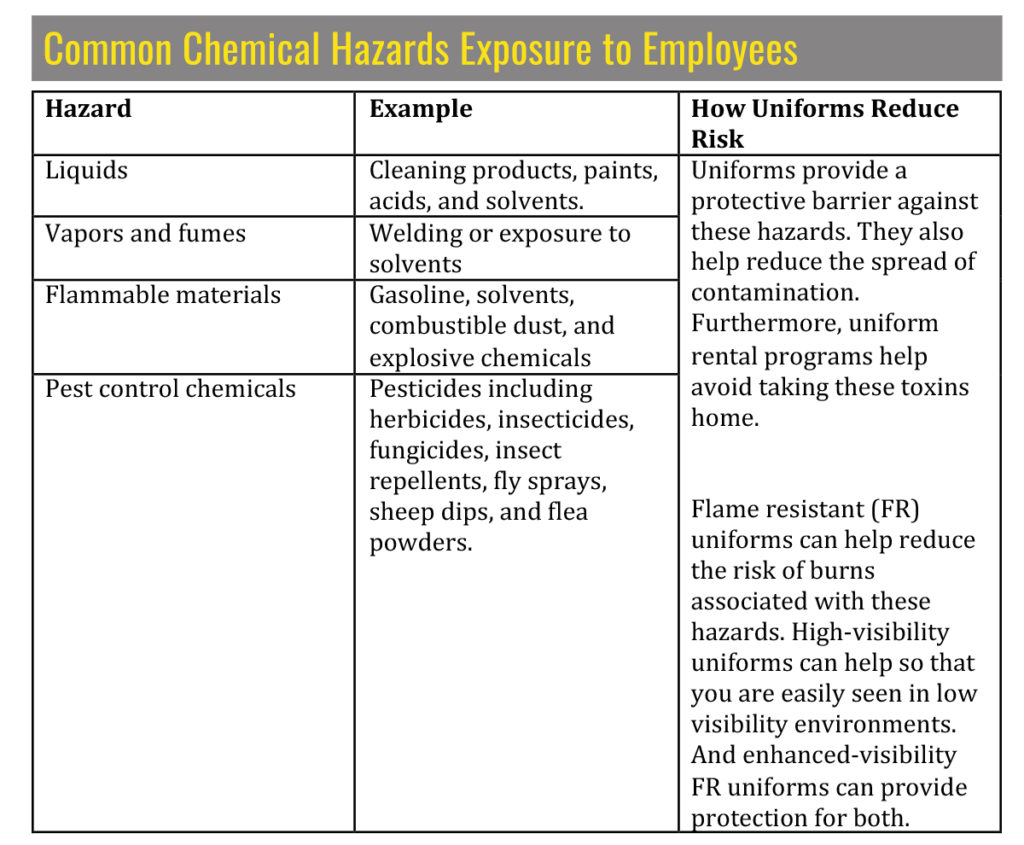
UNIQUE HAZARDS
Low Visibility
Low visibility work environments can be hazardous to employee safety. When it’s difficult to see someone, the chance for injury is higher. Such industries that benefit from high-visibility uniform options include those working in close proximity to moving vehicles (road construction zones) or in environments that are camouflaged by low-light conditions or complex surroundings (construction sites).
All of CITY’s high visibility garments are designed to meet ANSI 107 2015 compliance
Electric Arc Flash
Electric arcs are very serious safety hazards for those working with electric power. They occur when a “flashover of electric current leaves it intended path and travels through the air from one conductor to another, or to the ground.” Serious injury or even death can occur when a person is in close proximity.
Flame resistant (FR) uniforms can play a huge role in protecting employees. Due to the self-extinguishing nature of the garment, FR uniforms reduce the amount of burn impacting the body when exposed to an electrical ARC flash.
Flash Fire
A flash fire, now known as “short duration thermal exposure,” is a “sudden, intense fire caused by ignition of air and a dispersed flammable substance such as a solid (including dust), flammable or combustible liquid (such as an aerosol or fine mist), or a flammable gas.” Industries that are impacted include oil refineries, ethanol plants, fuel haulers, grain elevator operations, and more. FR uniforms can again protect employees from serious burns associated with short duration thermal exposure.
All of CITY’s flame resistant garments are designed to meet NFPA 70E regulations and OSHA 1910.269 regulations.
Low-Visibility and Flammable Conditions
Two distinct safety issues – low visibility and flammable conditions – affect certain industries. For example, employees working with combustible dust in a variety of industries are affected, such as agriculture, chemicals, food, grain, paper, pesticides, tire and rubber manufacturing, recycling operations, fossil fuel power generation (coal), and more. With the dispersion of dust particles, the environment is affected by low visibility as well as a chance for rapid combustion. This combination can be very dangerous.
With enhanced visibility flame resistant uniforms, individuals do not have to compromise their protection because they can be easily seen as well as protected against flammable conditions.
Take Home Toxins
Workers unknowingly expose their families to hazardous substances when they go home each day. Toxins are carried from work via work clothing, tools and equipment, and even an employee’s own hands. They are present in many industries and occupations including medical research, farming, chemical manufacturing, construction, and more.
The National Institute for Occupational Health and Safety (NIOSH) reports the following contaminants that cause ill health effects among workers and their families: beryllium, asbestos, lead, mercury, arsenic, cadmium, pesticides, caustic farm products, chlorinated hydrocarbons, estrogenic substances, asthmagens and allergens, fibrous glass, cyclothriethylenetriamine (RDX), and other infection agents (such as scabies and Q fever).
These toxins cause many ill-health effects including cancer, learning disabilities, impaired motor coordination, memory loss, liver problems, lung disease, asthma, seizures, and even death.
According to NIOSH, prevention is the best defense against bringing toxins into the home. A uniform rental program is a crucial element in that defense by providing employees with a laundry service for their uniforms. Employees never have to bring their uniforms home, which saves their families and children from being exposed to these harmful toxins.
*For a CITY article exclusively on Take Home Toxins, click here.
Electrostatic Discharge
Electrostatic discharge (ESD) is the release of static electricity when two objects come into contact. Most people have experienced a subtle form of ESD by receiving a small shock of static electricity when touching a metal doorknob or after removing clothes from a dryer.
Industries working with electrical and electronic parts, assemblies, and equipment understand the importance of avoiding ESD as such an event can dramatically damage or defect a device; worse yet, an employee could suffer an injury.
Our ESD uniform options offer significant protection against unwanted static charges and meet ANSI/ESD S20.20-2014 standards.
*For a CITY article exclusively on ESD, click here.
ADDITIONAL HAZARDS
Ergonomic Hazards
These hazards occur when the type of work conditions put strain on the body. Consequences of these hazards often include sore muscles (short-term effect), but with long-term exposure, more serious issues can occur. Examples involve frequent lifting, having to use excess force, awkward movements, and repetitive movements.
The goal of properly fitted uniforms is to eliminate discomfort and risk of injury due to work, which allows greater flexibility and comfortable movements.
Work Organization Hazards
These hazards include stress and strain from issues including workload, lack of control, and respect, etc. Two of the most common work organization hazards include discrimination/equality and lack of social support.
Uniforms can provide employees with advantages because:
- They promote equality. Uniforms break those socio-economic barriers that affect an employee’s sense of belonging. Furthermore, implementing a uniform program means that employees will be less likely to focus on who is wearing what and more on being productive, according to the Society for Human Resource Management (SHRM).
- They promote team spirit. Uniforms help employees feel equal to one another, and therefore they feel part of the team.
*For a CITY article exclusively on uniform advantages, click here.
UNIFORM CHARACTERISTICS
As uniform experts, we understand the benefits uniforms provide, but we also recognize how an actual uniform itself can be hazardous if used inadequately. Here are some examples:
- Emblems can create problems if they are inappropriately placed or incorrectly used. For example, FR uniforms should also have FR emblems to maintain flame resistant capabilities for the entire uniform.
- Zippers can become caught in moving machinery, which can cause great harm to an employee. Uniforms that offer buttons or snaps may be a better solution for some workplaces. Additionally, metal zippers and pulls may be hazardous in electrical environments, so having a plastic option would be beneficial.
- Buttons/snaps have the same issue as zippers as metal varieties may need to be discontinued in favor of plastic to avoid electrical hazards.
- Bulky uniforms/coats can decrease movement and flexibility. For example, someone working in an industrial manufacturing setting may wish to wear a bulky and heavy coat due to a cooler environment; however, an employee may suffer from muscle strain due to the heaviness of the garment. Additionally, it may be more difficult to move around in a manufacturing environment.
Because of these issues that arise with a uniform program, we help determine a company’s needs by completing facility needs assessment. This assessment ensures we are providing the best possible option for our clients.
INDUSTRIAL LAUNDRY
Flame resistant (FR), high visibility, and enhanced visibility uniforms require special laundering instructions to safeguard the integrity of the garment. By laundering it incorrectly, the wearer of such a uniform may be compromising the added-protection capabilities of the garment.
Luckily, an industrial laundry can help manage this by washing all garments using specific washing formulas and drying temperatures, as well as completing quality checks of the garment.
FIRST AID
In addition to providing safety-minded uniforms, we also offer clients a value-added service of first aid supply inventory management. We help clients improve their safe work environment with regularly scheduled visits to restock, remove expired products, and organize first aid supplies.
With a managed safety program, clients are able to provide their employees with consistent access to safety and health products, which helps increase overall health, morale, and productivity.
*For a CITY article exclusively on first aid, click here.
REGULATION UPDATES
Safety regulations are constantly evolving and improving. Staying on top of upcoming and changing policies is important to keep a company safe and compliant. CITY strives to stay up-to-date so that our clients have what they need, when they need it.
“It’s our job to know what’s happening in our industry,” Wetlaufer said. “We have good, active partnerships with leaders in our industry as well as vendors so that we can stay on top of the latest trends.”
It’s not only important for a company as a whole to stay updated, but it’s also beneficial for key people in your organization to understand when and why something has changed.
“Driving down information to make sure everyone understands the importance of why something is done a certain way really matters,” Wetlaufer said. “For example, if we don’t understand why we have to process FR garments a certain way, then we’re putting our customers at risk, and those customers are trusting us to make sure their garments have proper integrity.”
END USER TRAINING
Understanding regulations is not the end when it comes to staying compliant. It’s also crucial to understand how to properly use safety equipment such as uniforms, eye wash stations, or an AED (automated external defibrillator).
“We need to go one step further to make sure our clients know how to use those products within their business,” Wetlaufer added. “It’s all about risk mitigation to ensure people stay safe so clients can achieve their strategy and vision as a company.”
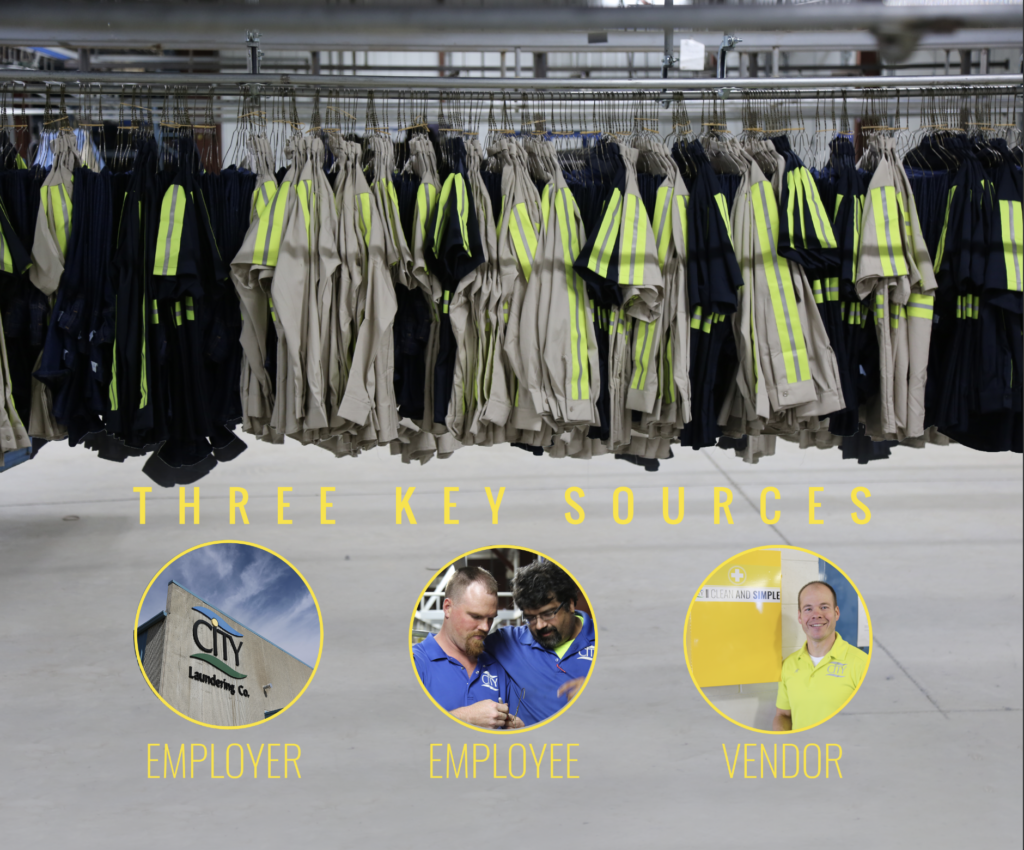
THE RESULTS OF SAFETY
Prevention of Injury
Making safety a priority with a documented safety program that is endorsed by top management is the easiest way to prevent injury and illness.
Improving Your Bottom Line
Studies show that with every dollar invested in injury prevention, businesses see a $2 to $6 return, according to Safety and Health Magazine. A quality safety and health management program can significantly reduce workplace injuries and illness and the costs associated with dealing workers’ compensation benefits, medical expenses, and lost productivity.
“When a business invests in a managed safety program, everyone wins,” Al Voigt, CITY facility services representative, said. “It truly shows employees that their safety is a top priority.”
SAFETY CULTURE
An effective safety culture doesn’t happen overnight, and there’s no tried-and-true formula for creating one, but it is rather a culmination of efforts of employers, leadership, employees, and supporting vendors. And when an organization values safety, identifies and corrects hazards, and encourages personal protection equipment, a culture of safety is created.
To learn how CITY can help you with your safety program, contact us here: https://www.citycleanandsimple.com/contact/
Comments
Comments are closed.